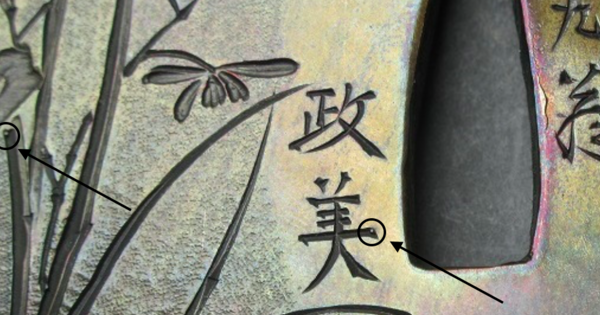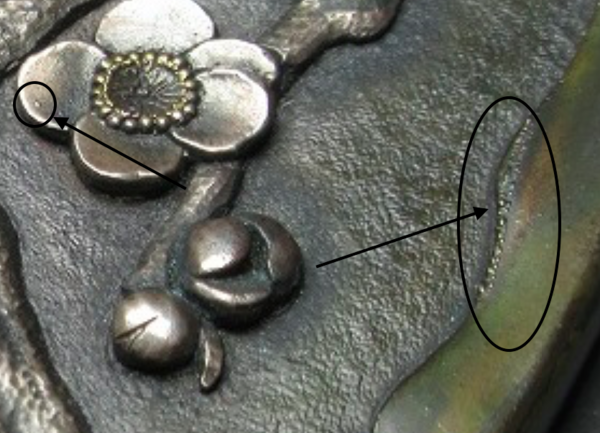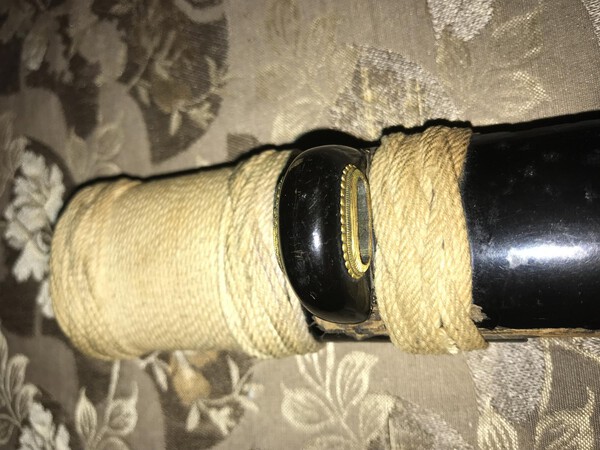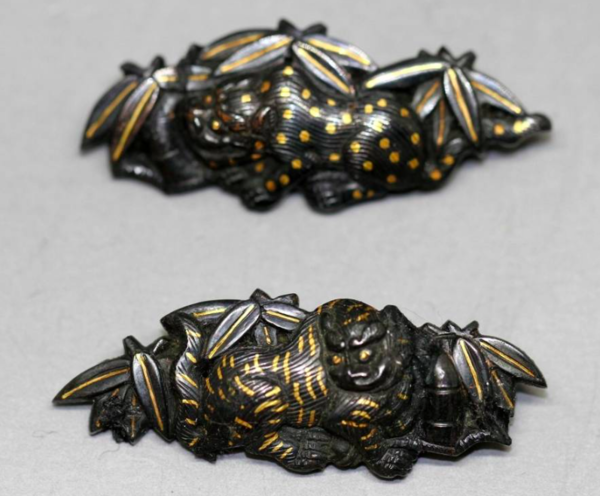-
Posts
858 -
Joined
-
Last visited
-
Days Won
7
Content Type
Profiles
Forums
Events
Store
Downloads
Gallery
Everything posted by Tanto54
-
Dear Stephen, The rubber is used to make an exact mold of an existing object (for example, a tsuba that you want to copy). Once the rubber is set, the object is removed from the rubber mold. Then hot wax is injected into the rubber mold under pressure. Once the wax is cooled, it is removed and placed in investment (which is like plaster of paris). The investment is then put in a kiln, melting out the wax. Thereafter, molten metal is poured into the cavity left in the hardened investment (where the wax copy was). After the metal cools a bit, the investment is dissolved in water leaving the metal copy. If done properly, this process can make a very good copy that has very fine details (as I mentioned before, up to the level of showing finger prints or a very clean signature in a copied tsuba).
-
Here's a short Youtube video on modern sand casting in Japan (notice the tsuba shaped trivets on the shelves at 2:12):
-
I re-read the link Marius provided on casting and want to correct an erroneous point that Chris Bowen made in that thread that could really mislead anyone researching the use and methods of cast iron. Chris claimed experience in casting iron and rebutted another member's comment about making multiple copies from a mold. Chris said that was not possible because the molding was done in sand and therefore the mold was destroyed and couldn't be used to make multiple copies. Chris is wrong because most often the true mold is a "positive" mold (made of wood or some other easy to model hard material) that is pressed into the wet sand to make a "negative" mold (and Chris should have known that if he had experience in sand casting). Therefore, many sand molds and copies could be made from that one "positive" mold very quickly. Just to be clear - I'm not saying that Japanese made cast iron tsuba before the Meji period. I don't have enough information to know one way or the other, so I am inclined to rely on the expertise of someone like Ford on that issue. Also, as I am often involved in trying to identify modern cast items that are masquerading as antique, I want to clarify the difference between antique sand casting, which does not reproduce fine detail, and modern investment casting (and vulcanized molding), which can reproduce very fine details down to signatures and even fingerprints.
-
Dear Peter, Thanks for bringing this to our attention - I've sent Mr. Hoppen a message.
-
Dear Omar, See this excellent research by Derek for a comparison of the various oils (including CLP). http://www.militaria.co.za/nmb/topic/16303-nihonto-oil-a-study/?hl=testing
-
Dear Patrice and Pete, I think that you are correct. The one on Yahoo Japan has signs of modern (recent) investment casting. These modern fakes are getting better and better (and may soon be difficult to identify). There is another tsuba with waves in the thread on silver fittings that shows similar signs of modern casting - this may soon become an epidemic.... These "positive" bubbles that show up in the corners on modern cast copies are often caused by air bubbles that adhere to the surface of the wax copy when it is covered in the investment material before burnout and casting. For example, if you look at the mei, there is a round "positive" bubble in the corner of one of the kanji - that wouldn't be there if it was carved instead of cast.
-
Dear Jeremiah, I see several signs of modern vulcanized molding and investment casting in your silver wave tsuba, suggesting that it is a copy made in the last few decades. Specifically I believe I see tiny casting bubbles (not referring to the sea spray), mold defects, porosity and residual cleanup signs (and the front and back of the tsuba are identical copies - including the defects...). Perhaps Ford can confirm this (I hope that I'm wrong, but I'm fairly sure that it's a recent cast copy, but in any event, it is cast).
-
Dear Richard, Thanks for this and similar posts. I always enjoy what you have to say and almost feel like I have the object in hand because of your fine pictures.
-
On sale on Yahoo Japan currently for $12..... https://page.auctions.yahoo.co.jp/jp/auction/g321828715
-
-

Show Your Presents - The Christmas Aftermath
Tanto54 replied to Teimei's topic in General Nihonto Related Discussion
Dear Ian, At least it wasn't socks.... -
Back in the 1970's, a friend opened his menuki kiribako to find that the little elastic bungee cords (that many of our menuki, kozuka and fuchigashira kiribako have) had caused a significant color change in the patina where it came into contact with his menuki. Eventually, he discovered that it was caused by vapors from one of the chemicals in the elastic. Since then, I've heard or seen other horror stories related to incorrect glues or dyes that cause damage to tosogu. In many areas of art, conservationists are careful to use acid free paper and special glues and materials to avoid ruining artwork (after years of exposure). You should be careful experimenting with dyes, fabrics, materials, lacquers, paints, glues, treated wood, plywood (glued together...) etc. around your treasures....
-
Hi Stephen, Hope all is well. I'm not bidding (but thanks for asking!).
-
Old post but trying to keep these together. Just saw this on Yahoo Japan - gimei but still... Notice how the teapot was cast to fit the tsuba and the use of the fuchigashira as a handle.
-
Dear Ken, With the lost wax method and a rubber casting mold many copies can be easily made. The original tsuba (or other object) is covered in many rubber sheets and put in a hot press which molds the rubber around the object and presses into the details. Then the mold is cut open and the original is removed. Thereafter, the mold is injected with hot wax under pressure which makes an identical wax copy of the original tsuba. Many such wax copies can be made from that mold in a few minutes. The wax copy is attached to wax "sprues" and then covered with a slurry like plaster of paris (the "hard" mold). The whole thing is put in a kiln which melts out the wax leaving a void in the "hard" mold that is the same as the original tsuba. Then molten metal is poured into the hard mold through the channels left by the wax sprues that melted away. The hard mold is then placed in water where the "plaster" dissolves leaving the tsuba (with sprues that are now metal attached). The sprues are cut off and the tsuba cleaned up and perhaps hand finished. This form of molding is so precise that it can replicate very fine detail (e.g., fingerprints). You can use this method to make many tsuba in just a few days (depending upon the amount of hand finishing). The line caused by cutting the original tsuba out of the rubber mold is often apparent in the finished product (the seam or flashing seen in the sukashi or on the mimi of some cast tsuba).
-
Dear Omar, With respect to the "tiny hairs" on the stems that you mentioned, would you point them out in one of the macro photos? When I look at some of the pictures, I can see chisel marks that someone could mistake for "tiny hairs", but they are really just marks caused by the chisel tightening the base metal against the inlay. If you watch Ford's video about making the Tiger Tsuba, you can see how the inlays are done and how these chisel marks could appear (i.e., your "tiny hairs" might not be an intentional part of the image - but Ford wouldn't leave them showing...).
-
Dear Ed, For what it is worth, I agree with Geraint - you will see these fuchigashira from time-to-time and yours is considerably better than most. The menuki disc is a tama (or sacred jewel). it is unusual to see it separate from the dragon (usually the dragon is clutching the tama in its claws. I've literally seen thousands of dragon & tama on tosogu, and this is one of the very few that I've seen where the tama is separate from the dragon (another was a tsuba where the dragon was on the front chasing the tama which was on the back). From Wikipedia: Jewels, pearls, moons, and tides are common motifs among Indian, Chinese, and Japanese dragons (Ingersoll 1928, de Visser 1913:13–14, 71, 88, 107). The Japanese word for "pearl", shinju 真珠 lit. "true jewel", compares with kanju 干珠 "tide-ebbing jewel" and manju 満珠 "tide-flowing jewel". This kanji 珠 is also pronounced tama, cognate with tama 玉 "jewel; gem; jade"...
-
I like it too. My guess would be Nara but shibuichi for the base material....
-
Dear Ray, The Vet that I purchased this sword from sheepishly admitted to doing the knot work himself. He said that the saya got battered up in the surrender/distribution process, so he knotted the cord to hold it together on the ship ride home.
-
Dear Ray, It's not beautiful knot work, but it came from a Navy WWII Vet just this way (and it has magnificent tosogu and housed a beautiful sword). This is the second sword that I purchased when I started out more than 45 years ago...
-
I really like the set too. Your menuki are probably based on a painting because I have seen that same composition many times before. Yours are much, much better, but here are some similarly composed menuki on sale at Yahoo Japan (not mine...) https://page.auctions.yahoo.co.jp/jp/auction/q250709451
-
Dear Brian, The characters at the top are Japanese but are surely written by a non-Japanese (probably Chinese). Also, note that the characters are written left to right and would usually be written top to bottom on a certificate.
-
Dear Ray, Thank you for posting this - very interesting. Can you (or someone else) tell us about the effectiveness of a microweld? Has it completely "fixed" the sword from a theoretical "usefulness" perspective? When I do a good job of welding using normal techniques (not on swords...) the weld will be stronger than other places in the piece, so if stressed, the metal breaks somewhere else (not at the weld). Is it the same for a good microweld? I really appreciate the honorable approach of not trying to hide the weld, but would you (or someone else) speculate on how visible the weld would have been if the Togi had polished it all the way down?
-
Yes, sorry to bring bad news, but both appear to be cast.











